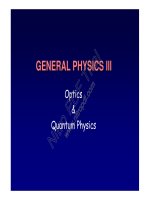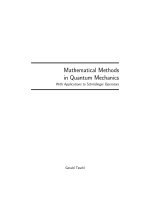- Trang chủ >>
- Khoa Học Tự Nhiên >>
- Vật lý
Chapter XXI Quantum Mechan
Bạn đang xem bản rút gọn của tài liệu. Xem và tải ngay bản đầy đủ của tài liệu tại đây (1.73 MB, 34 trang )
GENERAL PHYSICS III
GENERAL PHYSICS III
Optics
&
Quantum Physics
Nitro PDF Trial
www.nitropdf.com
Chapter XXI
Chapter XXI
Quantum Mechan
Quantum Mechan
ics
ics
§1. The wave nature of particles
§2. The Heisenberg Uncertainty Principle
§3. The Schrödinger equation
§4. Solutions for some quantum systems
Nitro PDF Trial
www.nitropdf.com
It has been known from the previous chapter that light, and in general,
electromagnetic waves have particle behavior.
Some latter time than the quantum theory of light, it was discovered
that particles show also wavelike behavior.
The wave-particle duality of matter is the fundamental concept of
modern physics
Newton’s classical physics should be replaced by the new mechanics
which is able to describe the wave nature of particles
“QUANTUM MECHANICS”
Nitro PDF Trial
www.nitropdf.com
§1. The wave nature of particles:
1.1 De Broglie hypothesis:
In 1923, de Broglie put a simple, but extremely important idea which
initiated the development of the quantum theory. He proposed that,
if light is dualistic (behaving in some situations like waves and in others
like particles) → this duality should also hold for matter. It means that
electrons, alpha particles, protons,…, which we usually think of as
particles, may in some situations behave like waves.
A particle shoud have a wavelength related to its momentum in exactly
the same way as photon
h
p
=
(the de Broglie wavelength)
And the relation between frequency and particle’s energy is also in
the same way as photon
=
E
h
Nitro PDF Trial
www.nitropdf.com
1.2 Macroscopic and microscopic world:
Question: Why do we not observe the wave nature of particles in our
experience of the macroscopic world?
The answer is given by two following examples:
Apply the de Broglie hypothesis to two cases, the first on the
macroscopic scale, and the second on the microscopic scale
The case of macroscopic particles:
A particle with m = 10 kg, v = 10 m/s p = 100 kg.m/s
= h/p = (6.63x10
-34
/ 100) m = 6.63x10
-36
m .
With this scale of wavelengths a mcroscopic particle can not
produce any observable effect of interference or diffraction.
The case of microscopic particles:
An electron with m = 9.1x10
-31
kg, accelerated to v = 4.4x10
6
m/s
p = 4.x10
-24
kg.m/s = h/p = 1.65x10
-10
m.
With this scale of wavelengths one can observe interference and
diffraction effects of electrons on atoms or molecules of crystal.
Nitro PDF Trial
www.nitropdf.com
1.3 Electron diffraction:
Davisson & Germer
experiment (1927):
• Elecrons emitted thermally
from the cathode C
• Then they are accelated by
a voltage V a parallel beam
of monoenergetic electrons
are produced.
• A plate P & a diagraph D plays the role of
a detector which measures the number of
scattered electrons.
The experimental graph shows the angular
distribution of the number of scattered
electrons (for V = 54 volts).
There is a peak at
= 50
o
.
Nitro PDF Trial
www.nitropdf.com
Explanation:
• The existence of the peak at = 50
o
proves qualitatively &
quantitatively the de Broglie hypothesis !
Such a peak can only explained as a constructive interference of waves
scattered by the periodically placed atoms
• With electron beam of such low intensity that the electron go through
the apparatus one at a time the interference pattern remains the same
the interference is between waves associated with single electron.
• For a quantitative consideration, we calculate the electron wavelength:
by using = h/p, where eV = p
2
/2m p = 2meV
Substuting V = 54 volts, one gets = 1.67x10
-10
m
by using the formula for the first order diffraction peak
= d sinwhere d was detemined from X-rays diffraction
experiments, d = 2.15x10
-10
m.
For = 50
o
, one gets = 1.65x10
-10
m
The two obtained values of agree within the accuracy with experiment !
Nitro PDF Trial
www.nitropdf.com
1.4 Application
1.4 Application
of Matter Waves:
of Matter Waves:
Electron
Electron
Microscopy
Microscopy
The ability to “resolve” tiny objects improves as the wavelength
decreases. Consider the microscope objective:
A good microscope objective has f/D 2, so with ~ 500 nm
the optical microscope has a resolution of d
min
1 m.
D
f
fd
c
22.1
min
• Nominal (conventional) minimumangle for resolution:
• The minimum d for which we can still resolve two objects is
c
times the focal length:
D
c
22.1
Objects
to be
resolved
diffraction
disks
D
d
f
= focal length of lens
We can do much better with matter waves because, as electrons with
energies of a few keV have wavelengths less than 1 nm.
Nitro PDF Trial
www.nitropdf.com
Example: Observation of a virus by an electron microscopyExample: Observation of a virus by an electron microscopy
eVk.
nm.
nmeV.
m
h
E 65
01640
5051
2
2
2
2
2
D
f
.d
min
221
nm
f
D
nm
f
D
d 0164.0
22.1
2
22.1
min
To accelerate an electron to an energy of 5.6 keV requires 5.6 kilovolts .
You wish to observe a virus with a diameter of 20 nm,
which is much too small to observe with an optical
microscope. Calculate the voltage required to produce an
electron DeBroglie wavelength suitable for studying this
virus with a resolution of d
min
= 2 nm. The “f-number” for
an electron microscope is quite large: f/D 100.
(Hint: First find required to achieve d
min
with the given
f/D. Then find E of an electron from .)
object
f
electron
gun
D
Nitro PDF Trial
www.nitropdf.com
§
§
2. Heisenberg
2. Heisenberg
Uncertainty
Uncertainty
Principle:
Principle:
2.1 Wave packet and uncertainty:
Wave-like properties of particles (electrons, photons, etc.) reflect a
fundamental uncertainty in the “knowability” (existence?) of the
particle’s precise location.
For classical waves one can produce a localized “wave packet” by
superposing waves with a range of wave vectors k. E.g.:
k: the spread in wave number
x: the spread in coordinate (the size
of the wave packet)
• For wave packets: k.x 1 (see the next slides in more details)
Interpretation:
To make a short wavepacket requires a broad spread in wavelengths.
Conversely, a single-wavelength wave would extend forever.
x
Nitro PDF Trial
www.nitropdf.com
From the quantum relation between momentum and wavelength p = h/
and the relation k = 2/ p = (h/2).k = ħ.k, where ħh/2(“h-
bar”) we have a relation between the spread in the particle’s locations
x and likely momenta p
ħ(k·x 1) (ħk)·x ħ p
x
·x ħ
This relation is known as the Heisenberg Uncertainty Principle.
To understand the relation k·x 1 we consider the following
example
k → 0
Wave with definite k () monochromatic plane wave
Nitro PDF Trial
www.nitropdf.com
Numerical example of
a wavepacket:
• Consider the superposition
of 7 sinusoidal waves with
the frequencies & amplitudes
as below. The component
waves have a “spead” in
k
,
denoted by
k.
The result has such form
k
Nitro PDF Trial
www.nitropdf.com
• The superposition of an infinite
set of waves with the same “spread”
k
has the form which is called
“wave packet”
Wave packet
Note that in the case of an infinite
set of component waves which cover
a continum of
k
values, the
superposition is a single wave packet.
The Fourier mathematical analytics can
provide rigorously the foundation
for this result. The wave packet
y(x)
is represented by the following integral:
From this integral one can show that
k
(the “spread” in
k
) and
x
(the
“spread” in
x
) are related through the equation
k.x 1.
Nitro PDF Trial
www.nitropdf.com








![Lecture notes on c algebras and quantum mechanics [jnl article] n lamdsman](https://media.store123doc.com/images/document/14/rc/rt/medium_6PjfnHupCQ.jpg)
